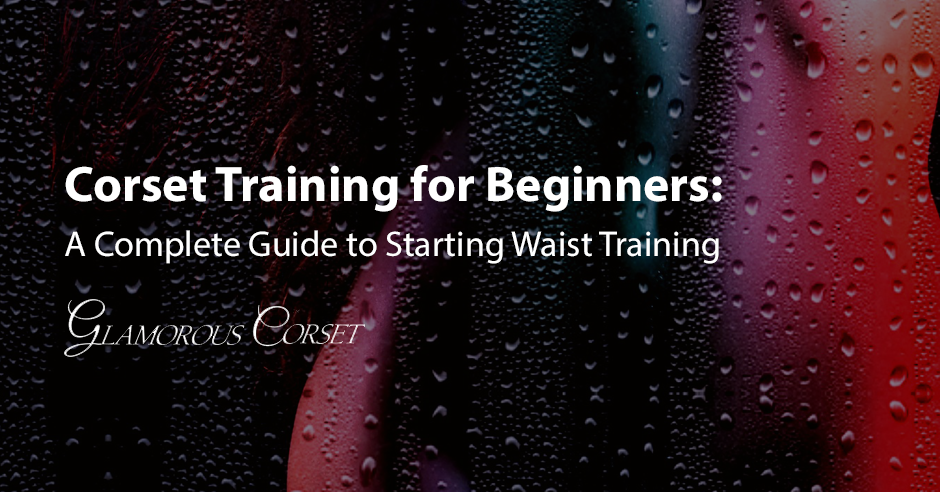Blog
Corset Training for Beginners: A Complete Guide to Starting Waist Training
You’ve probably heard that anything worth doing is worth doing well, and yet, we live in an era where instant gratification is almost expected.
There are pills to make you lose weight extra fast, hair dyes that you can spray on in about 30 seconds (and wash out the next day), bullet trains speeding from point A to point B, and shipping options that deliver goods to your door the same day.
These days, it’s practically a crime to ignore a text message. If you don’t respond within 3.5 seconds, people will assume you’ve come to serious harm.
This is the price of being connected. That said, there are still things that take some time to accomplish, and if you want to create a semi-permanent hourglass figure and look fantastic in the process, you’re going to have to spend some time waist training.
Let’s be clear, we’re not talking about the celebrity trend of wearing flexible waist cinchers during your exercise routine. First, um…why? Like you need more deterrents to working out?
Second, there’s no proof this actually helps you shed pounds, inches, or anything else. Please stop listening to the Kardashians!
What we’re talking about is the use of rigid, steel boned corsets to incrementally and semi-permanently reduce the circumference of your waist.
Whether you want to look great while shedding baby weight, you’re keen to corral your curves into pinup proportions, or you simply want to cut a sleek silhouette under your outfits, waist training can help you to reach your goals.
How does it work? If you’re interested in corset training for beginners, here’s the 411 on transitioning from untamed tummy to corseted core.
What is Waist Training?
Waist training, in a nutshell, is a form of body modification. Don’t worry, it doesn’t involve the use of permanent ink or piercings that will make your parents uncomfortable and limit your job prospects. That’s a whole other therapy session!
As mentioned above, waist training involves wearing a steel boned corset to achieve a smaller waist line, but that’s just the beginning. Anyone can wear a corset on occasion to cinch the waist, smooth the midsection, and streamline a formal gown.
Waist training is a process that includes working your way up to wearing a corset every day, for the majority of the day, and then incrementally tightening the laces over time to achieve a significantly smaller waist.
The goal is to achieve semi-permanent results, so that your waist remains smaller even when you take your corset off.
This, of course, takes time, which is why the practice is called waist training.
Choosing the Right Corset
Okay, now that you understand what waist training is, it’s time to put on the training wheels, or put the training wheels in motion. Um, yeah. Let’s just forget about the wheels and get started with tips for choosing the perfect corset!
There are in-depth tutorials on this subject alone, but we’ll just go over the basics.
First, you need to take measurements so you know your starting size. You’ll want to measure your underbust, natural waist, hips, and torso length.
If you are interested in overbust options, you should measure your bust line, as well.
These measurements can help you to find the right sizing for your body and decide if options like waspies or longline corsets might be right for your needs.
Remember, if corsets come in sizes like S/M/L, they’re probably fashion or costume corsets. You want to look for options that include bust, waist, and other sizing information in inches, as well as steel boning – this is very important!
If you’re new to waist training, you should try before you buy, or if you order online, check the return policy to make sure you can return or exchange your corset.
In addition, you’ll want to select a corset size 4-6 inches smaller than your current waist measurement. For instance if your natural waist is 32 inches you would select a 26″ or 28″ corset.
Don’t forget, you can also consider purchasing custom corsets that are tailor-made for your dimensions and your particular goals.
When you’re first starting out and you’re not sure how you’re going to fare, you might want to begin with an off-the-rack option.
As you work your way up to wearing your corset throughout the day, however, you may find it well worthwhile to spend more on custom-fitted waist training garments.
Seasoning Your Corset
Before you can really start your waist training journey, you need to season your corset.
If you put it on and tightlace right off the bat (i.e. tighten the laces significantly, by more than a couple of inches) you could warp the boning, stress the fabric, and probably cause yourself some physical harm.
You need to take the time to mold the garment to comfortably hug your body.
This can be done in a couple of weeks, or perhaps a little longer if you’re a newbie.
All you have to do is lace your corset snugly, but not tightly (taking no more than 1-2 inches off the waist line).
From there you’ll want to wear your corset for just a couple of hours a day for about three days, then increase wear incrementally over the course of 2-3 weeks until you’re wearing it eight hours a day.
Viola, your corset is ready to start waist training!
Your Waist Training Schedule
There is no set schedule for waist training. Creating a schedule has to do with the goals you want to accomplish and your comfort level.
What you never want to do is risk your health and wellness in order to achieve speedy results.
Can you cinch your corset tight enough to take four inches off your waist right this second? Yeah, sure, if you like bruising your ribs and passing out when you stand up.
If you want to remove four or more inches from your waist, your mantra should be “slow and steady wins the race”. In a matter of weeks or months, you could see the semi-permanent results you crave without torturing yourself.
Some ladies with a lot of experience waist training can safely tightlace, but until you know your comfort level, you should probably hold off. In the meantime, you can start with the following schedule of corset training for beginners.
If you feel comfortable wearing a snug corset 3-4 hours a day, add 1-2 hours daily each week until you’re wearing your corset all day, every day.
When you’ve done this, you can start lacing your corset a little tighter, taking 0.5-1 inch off your waist. See how that feels for a couple of weeks. If you feel good, you can start lacing a little tighter.
Eventually, you can downsize to a smaller corset, and by this time you should start to see semi-permanent results.
Remember, comfort is important and there is no strict schedule, so take your time for the best opportunity to achieve your goals in the long-term.
Setting Waist Training Goals
Until you start waist training, you may not have the knowledge and experience to set realistic goals. You can certainly have a size and a date in mind, like whittling four inches off your waist in time for your sister’s wedding in six months, but this may or may not happen, depending on your particular waist training journey. As a beginner, you just need to give yourself time to learn and adjust, knowing that you can set attainable goals and change them as you go.
Stay up-to-date with weekly blog posts, waist training tips, and the chance to win one of our monthly corset giveaways, like us on Facebook & subscribe to our mailing list today! Want to find the perfect corset? Shop some of our favorites: underbust corsets, overbust corsets, corset dresses.

My name is Rachel, I am the owner of Glamorous Corset, a small business founded by me in 2010. Back In 2005, I was in a car accident that left me with a herniated disk. Much to my surprise I learned steel boned corsets were beneficial to several medical injuries including mine. I was always intrigued with corsetry, their history and their beautiful aesthetic. I love sharing knowledge about corsets, educating my wonderful readers and breaking the negative stigma related to corsetry. In combination with my years of research and personal experience I hope my articles are useful and can help anyone who has struggled with some of the same things I have. More about me…


